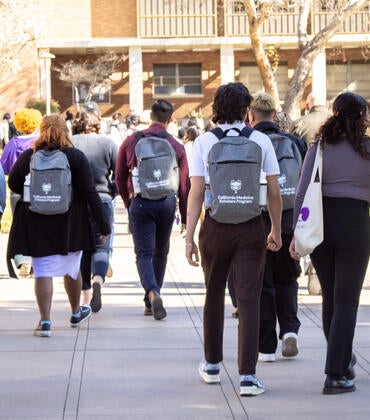Size does not matter. Certainly not when it comes to tiny worms securing the attention of biologists. One such biologist, Morris F. Maduro at the University of California, Riverside, has just been awarded a grant of nearly $1.3 million from the National Science Foundation, or NSF, to study a worm (or nematode) about a millimeter in length.
The research project will focus on the gut of Pristionchus pacificus. Like most nematodes, P. pacificus develops quickly, its growth from embryo to adult taking just four days. It is a complete animal, with a nervous system, skin, intestine, and muscles. Nematodes of the genus Pristionchus are a distant relative of the well-studied species Caenorhabditis elegans, used by biologists as a model organism to study animal development and behavior.
Funded for four years, the research project will focus on changes in the gene network that specify the early intestinal precursor cells in nematodes like P. pacificus. Gene networks describe how genes turn each other on and off. Precursor cells are stem cells that can differentiate — or specialize — into only one cell type.
“During embryonic development, gene networks cause cells to develop along pathways of differentiation, resulting in cells becoming specialized in their function,” said Maduro, a professor of molecular, cell and systems biology who has studied nematodes for more than two decades. “Changes in such networks occur over evolutionary time and in human disease. For more than 25 years, gut specification was studied in only a single species, C. elegans, and its close relatives. The NSF grant will allow us to extend our work into the genus Pristionchus.”
P. pacificus is usually found in association with a species of scarab beetle, while C. elegans is free-living and usually found on rotting fruit. P. pacificus has some adaptations, such as a mouth with a little tooth for eating the corpses of dead beetles. As a result, P. pacificus can attack other nematodes and is more predatory than C. elegans. C. elegans tends to eat mostly bacteria and fungi.
“Pristionchus embryos look a like those of C. elegans,” Maduro said. “But even when the phenotype, the outward form of the animal, doesn’t change, the genes behind the scenes can still change. This phenomenon is called developmental system drift, paralleling the term genetic drift. Entire sets of genes can change while their overall function does not. In other words, the endpoint, whether it’s C. elegans or P. pacificus or another nematode species, still looks like a nematode. This means Pristionchus makes its gut in a different way than C. elegans. This idea that genes change when the phenotype looks the same among species is probably quite widespread.”
Eric S. Haag, a professor of biology at the University of Maryland who will not be participating in the research project, said he is excited to learn more about Maduro’s work.
“Biologists have long sought to understand how new features of animal bodies get encoded by new genomic instructions. But we now know that even the genes that construct ancient traits still undergo evolutionary changes,” Haag said. “Dr. Maduro’s work uses a very manipulable type of nematode to explore this paradoxical fact. Within a group of worms with very similar digestive systems, some species have re-invented the genetic circuits that control their development. It’s so surprising, and I can’t wait to learn about what they find.”
Maduro explained that gene network changes can occur due to mutations or infection and can lead to diseases such as cancer.
“Nematodes are a powerful model system for us to study how gene networks can change, because we can get answers inexpensively and on a short time scale,” he said. “By comparing Pristionchus and C. elegans, we hope to learn fundamental principles about how gene networks can become more complex.”
The project will use a combination of bioinformatic and genetics methods to understand how the simple embryonic gene network in an ancestral Pristionchus species underwent expansion over evolutionary time to form a more complex network.
“Two technologies have allowed researchers to address the explosion of this and other evolutionary questions we see today,” Maduro said. “They are (a) rapid genome sequencing at low cost and (b) the ability to use CRISPR to knock out genes in the genome at low cost and high efficiency.”
Maduro added that nematode species can be found in almost every ecological niche on Earth.
“There are maybe a million different species,” he said. “We can only study a small number of them. Pristionchus garnered scientific interest only about 25 years ago and research took off in earnest in the past decade when CRISPR became available to simplify gene editing. P. pacificus has three genes that specify the gut, but other related species have fewer genes. We have an opportunity to study the stepwise evolution of how this network got bigger and more complicated.”
Preliminary work in Maduro’s lab identified two of these three expanded genes in Pristionchus. When the gene pair was deleted, the gut disappeared in about half of the worms.
“We now need to delete that third gene to make sure we know that’s the only other gene that leads to gut specification,” Maduro said. “This grant will help us do that.”
The project will provide teaching and training opportunities for graduate and undergraduate students, including through a freshman laboratory course in nematode genetics, bioinformatics, microscopy, and molecular biology. Four undergraduate students will receive summer support for each year of the grant to work on projects related to Pristionchus. The grant will support up to two graduate students. Maduro will be assisted in the research by his wife, Gina Broitman-Maduro, an associate specialist in his lab.
The start date of the grant is January 15, 2024.
Header image shows Morris Maduro (standing) and Gina Broitman-Maduro. (UCR/Stan Lim)



